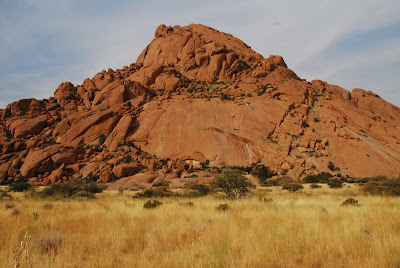


Claire has been keeping a secret desire to throw herself out of a plane and after being assured by our tour guides that this company (Groundrush Adventures Swakopmund) was reputable and safe she signed up with 6 other people from the truck. Why chose Africa to jump out of a plane? Well, in Swakopmund you can see the South Atlantic Ocean meet the Nambiban Desert. The jump was scheduled for the afternoon we arrived so they headed out to the airstrip in the desert only to be told when they got there that the winds at jumping altitude were too strong and they would need to return the next day.

 For some reason this photo wouldn't load up the correct way. Cartwheeling out!
For some reason this photo wouldn't load up the correct way. Cartwheeling out!
 Dreiss is giving the camera man the count down for the shute while I check out the view
Dreiss is giving the camera man the count down for the shute while I check out the view I was completely unprepared for the shute to open. When the shute is open you feel like you are floating. It wasn't until this point that the difference in speed is noticed from the free fall. Dreiss gave me control of the shute but my arms were too shaky with adrenaline to be able to do any manuovers. The free fall was apparently about 30secs and 3min or so once the shute was open. Our landing wasn't so graceful as I didn't process the 'straigten your legs' command until after I hit the ground
I was completely unprepared for the shute to open. When the shute is open you feel like you are floating. It wasn't until this point that the difference in speed is noticed from the free fall. Dreiss gave me control of the shute but my arms were too shaky with adrenaline to be able to do any manuovers. The free fall was apparently about 30secs and 3min or so once the shute was open. Our landing wasn't so graceful as I didn't process the 'straigten your legs' command until after I hit the ground There aren't enough positive adjectives to describe this experience. All of us wished we could do it again, this time know what to expect and being a bit more relaxed about it. The funniest incident of the day happened to one of the other guys from the truck. Just as he went to jump his shoe fell off and to the surprise of the ground assistants, landed in the middle of the airstrip a few minutes ahead of the owner. He was very relieved as he was due at quadbiking straight after his jump and didn't have time to return to the hostel for new shoes.
There aren't enough positive adjectives to describe this experience. All of us wished we could do it again, this time know what to expect and being a bit more relaxed about it. The funniest incident of the day happened to one of the other guys from the truck. Just as he went to jump his shoe fell off and to the surprise of the ground assistants, landed in the middle of the airstrip a few minutes ahead of the owner. He was very relieved as he was due at quadbiking straight after his jump and didn't have time to return to the hostel for new shoes.For those that have never been sandboarding, it is similar to snow boarding, but on the 120 metre high sanddunes. Mark & Dan joined Steve along with the Dutch couple, and were very excited when we arrived at the base of the dune just in time for the weather to clear.
This photo is from Claire's skydive DVD and is the location for the boarding.





 All in all, a fantastic experience. Unfortunately we're still waiting for the DVD footage of our boarding to come.......... so these photos are courtesy of Dan.
All in all, a fantastic experience. Unfortunately we're still waiting for the DVD footage of our boarding to come.......... so these photos are courtesy of Dan.Quadbiking
The afternoon activity was Quad Biking on the dunes. Again the scenery was incredible. There were a couple varieties of bikes, from Automatic (but less powerful), Semi-Automatic (you had to change gears, but you didn't have to worry about a clutch), and Manual (which were apparently the fastest). Most of us went for the semi-automatic, which was a good choice.
As the dunes are a protected area, there are only certain parts that we were able to drive on. Basically we were split off into groups of about 6, and it was follow the leader. The only exception to this was Johannes, who can only be described as a crazy man behind the wheel!
We weaved our way up & down & around the dunes, and eventually made it to "the lookout" which was a point high on the dunes but close to the coast. To see the sand dunes plunge straight into the ocean was a fantastic memory.
The final memory I had to take away from the quadbiking experience was my melted trekking pants! It seemed that my right leg was resting against a hot part of the engine, which i hadn't noticed during the noisy & bumpy ride. I was glad that they had lasted the majority of our African adventure, as we were on the home stretch now.


















































